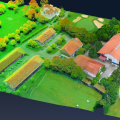
Geospatial analysis has helped reveal new information on how best to improve mosquito control efforts in the Northern Territory, according to a new study.
The joint study by researchers from Charles Darwin University and the Centre for Disease Control monitored the spraying of the habitats of the northern salt marsh mosquito in coastal wetlands near the northern suburbs of Darwin.
The species carries Ross River virus and Barmah forest virus.
“In order to improve aerial larval control efforts, we sought to identify the most important vegetation categories and climatic/seasonal aspects associated with control operations in these wetlands,” says the study.
By using a model to compare aerial control for each vegetation category, the researchers found that mangrove areas require the greatest amount of spraying. The results also show that marsh grass areas require extensive spraying after rain and high tides.
The research found that the period from September to January, with a peak in November and December, required the most spraying to control populations.
A companion paper identifies the vegetation categories most associated with the mosquito larvae population densities in the coastal wetland.
It found that larval control is best accomplished by concentrating aerial control efforts on drains, mangroves, and tide-affected reticulate areas, commencing early after the wet season.







